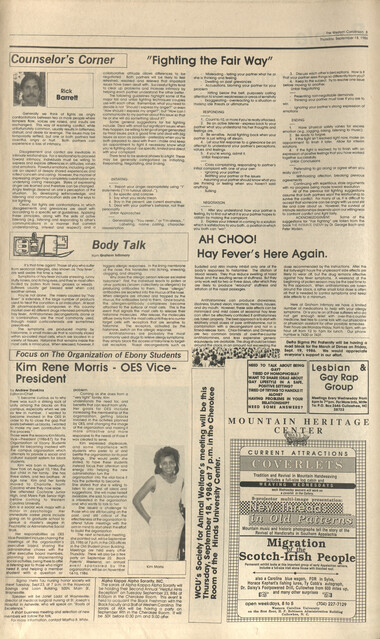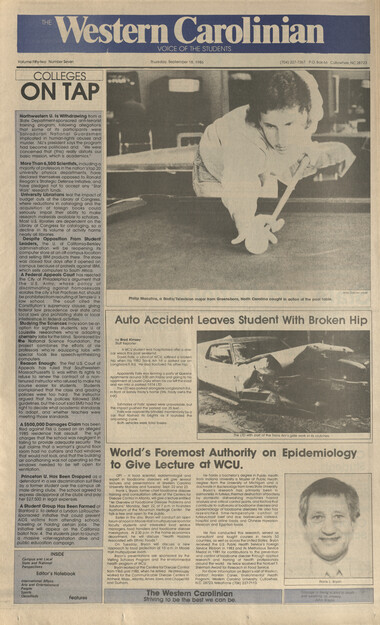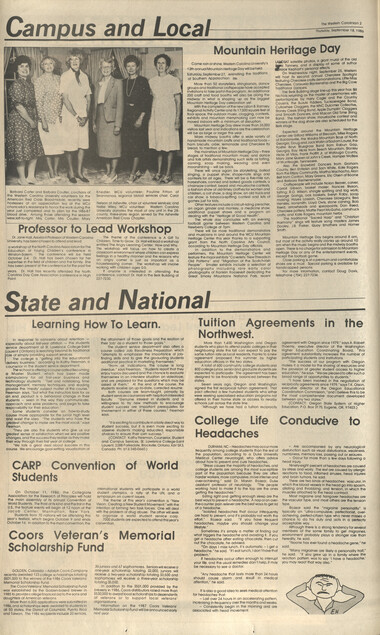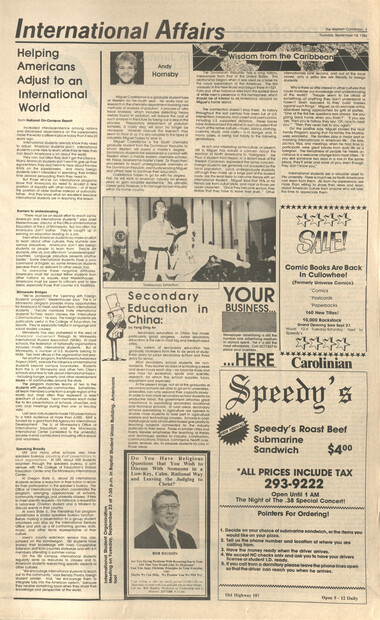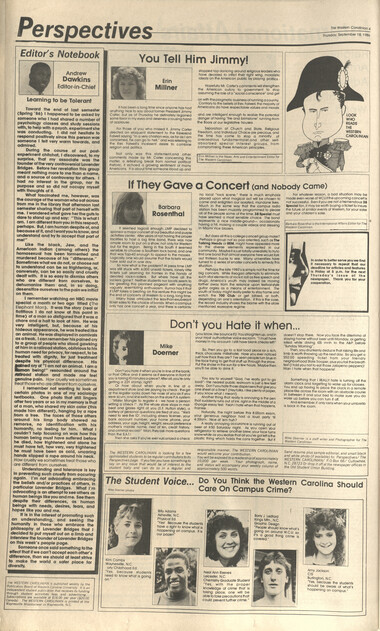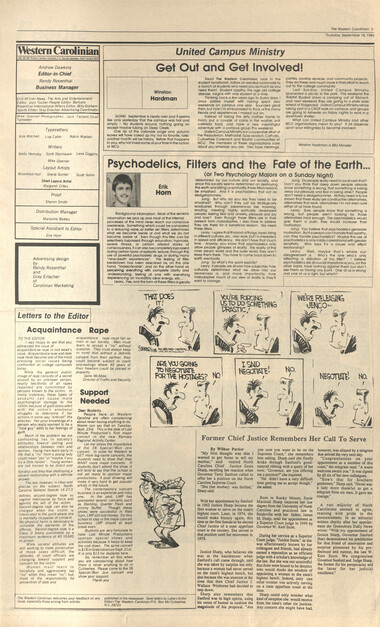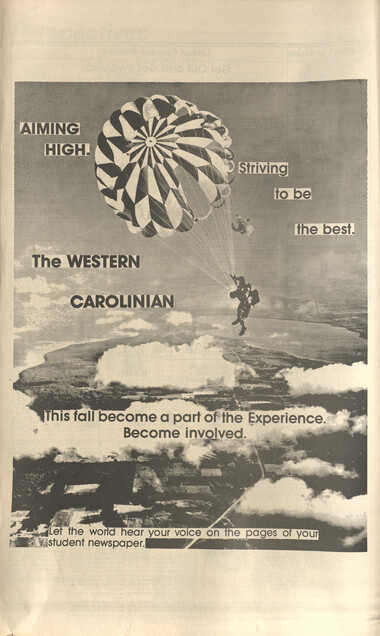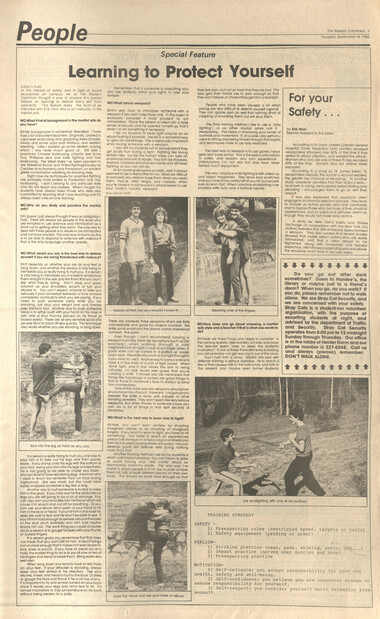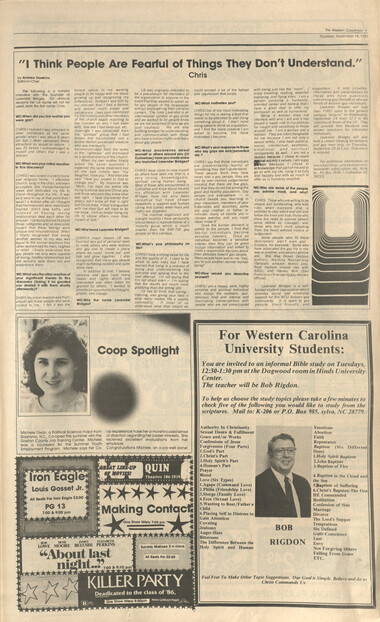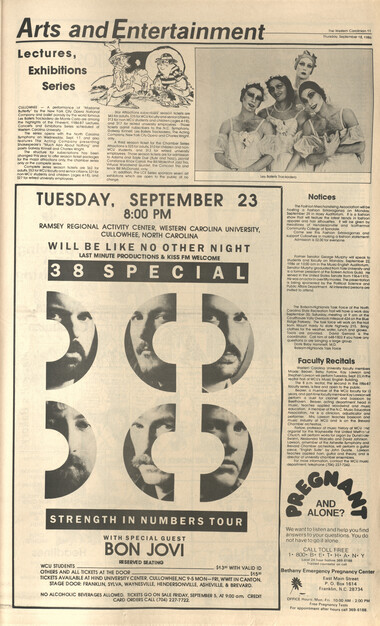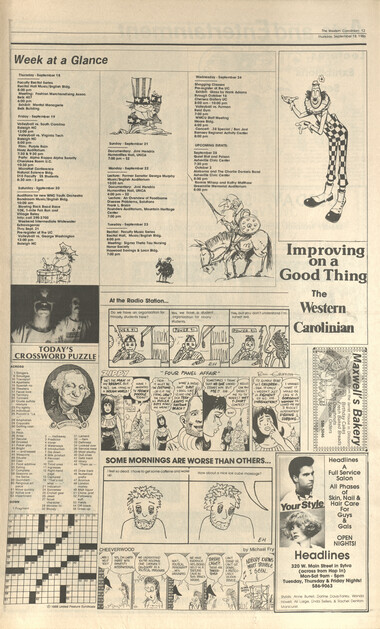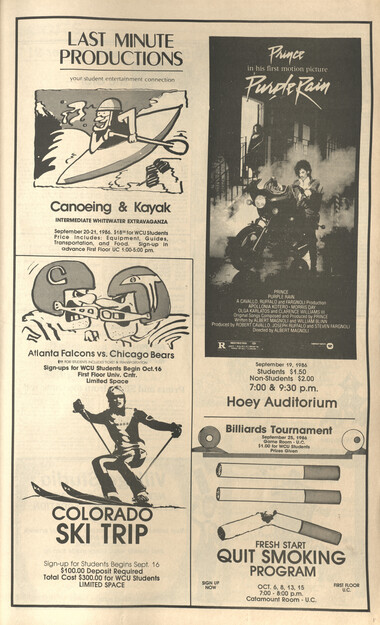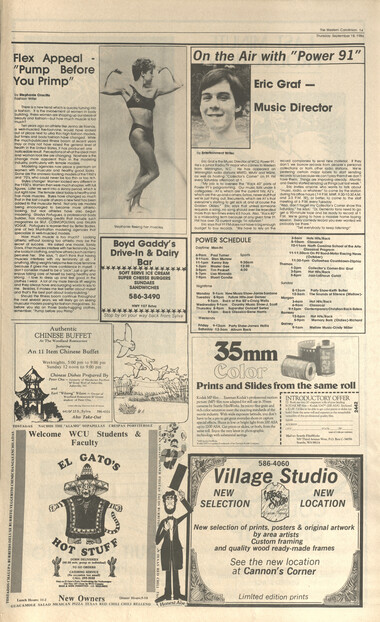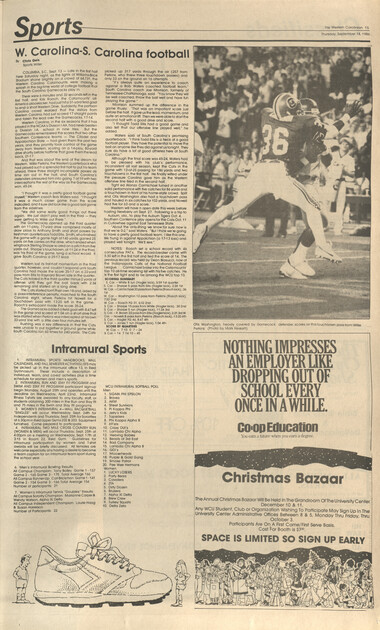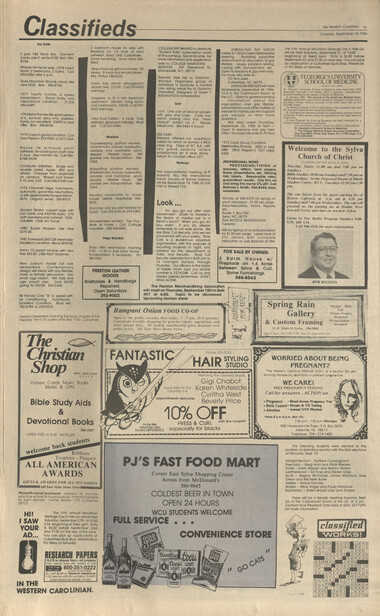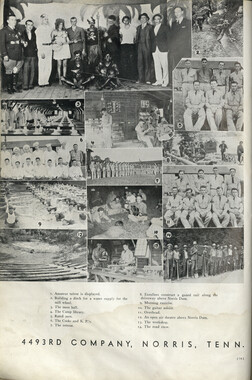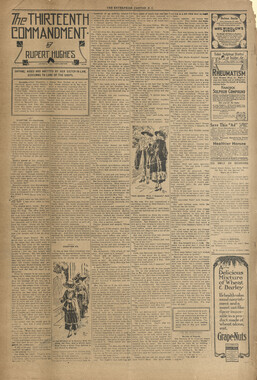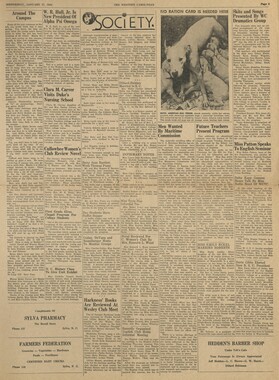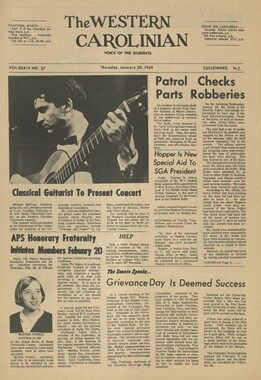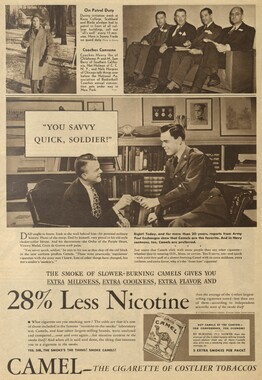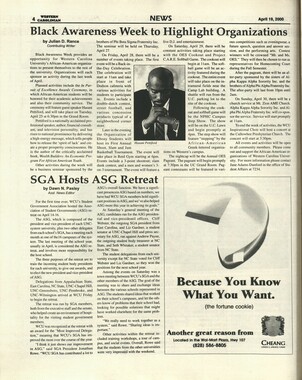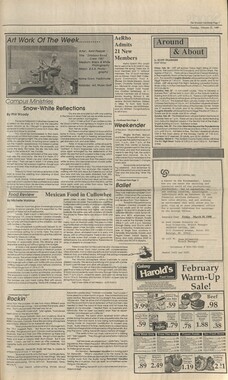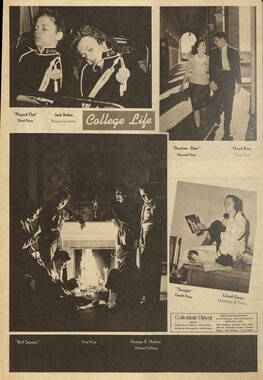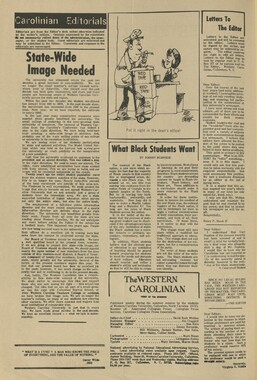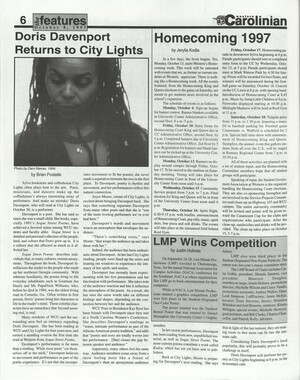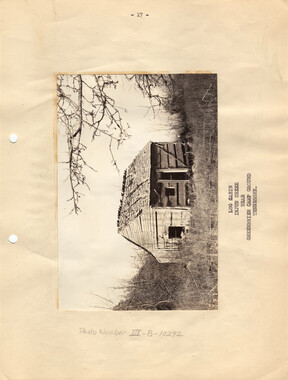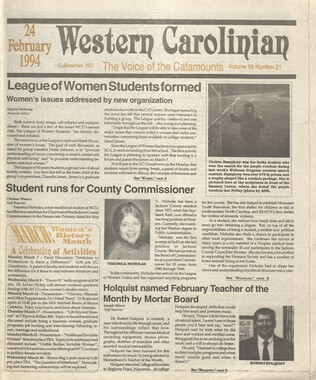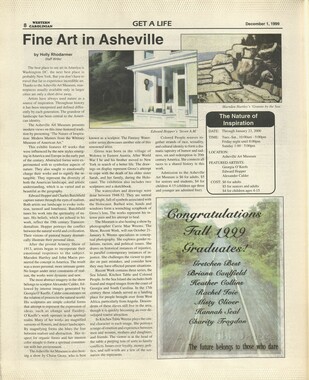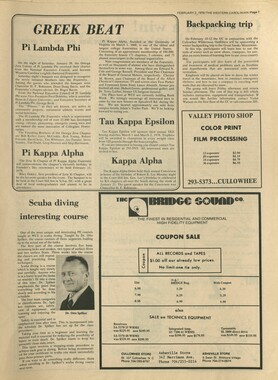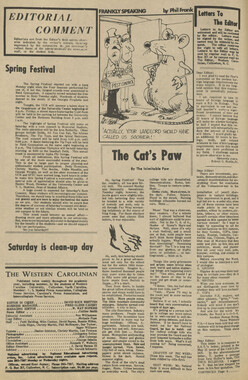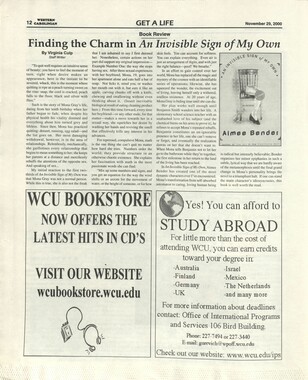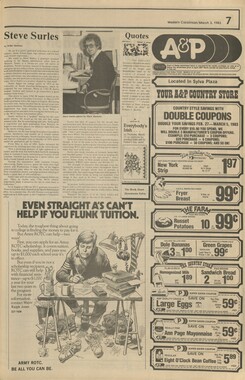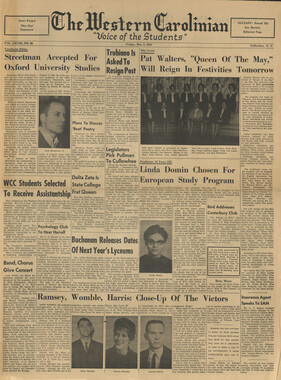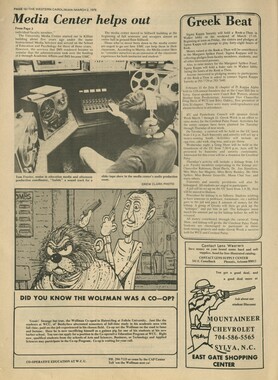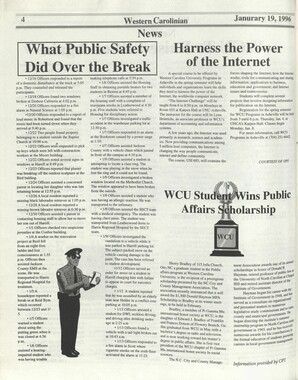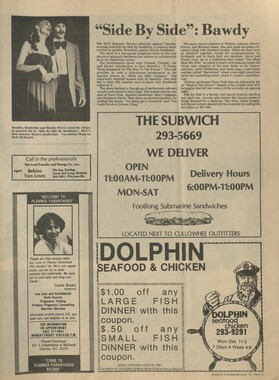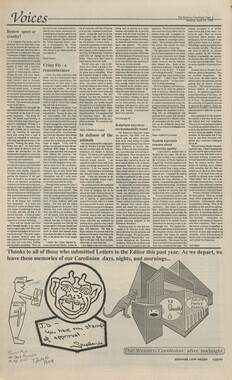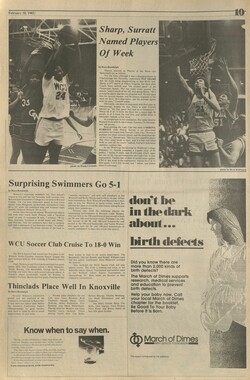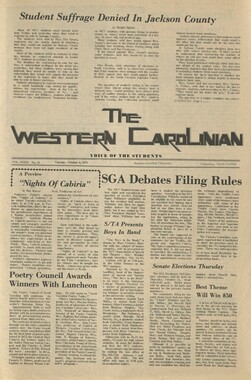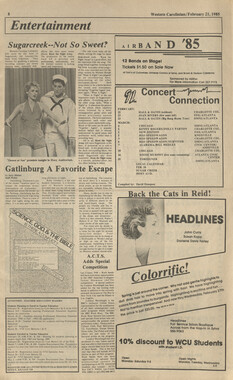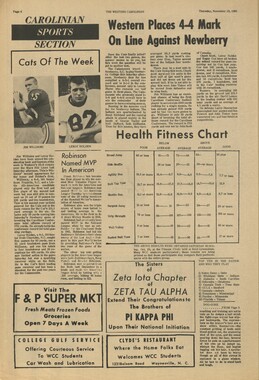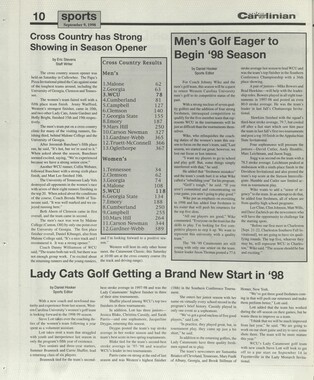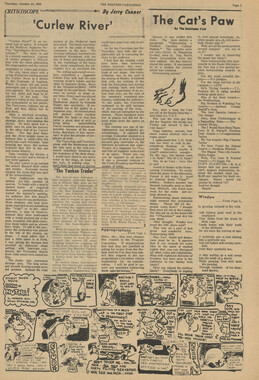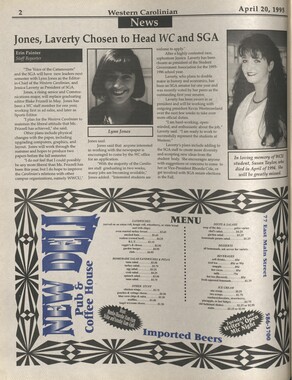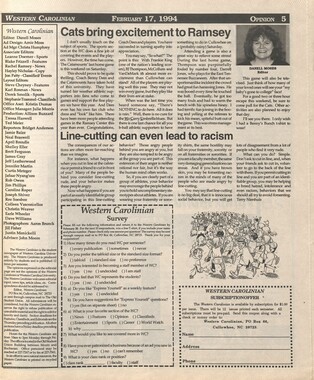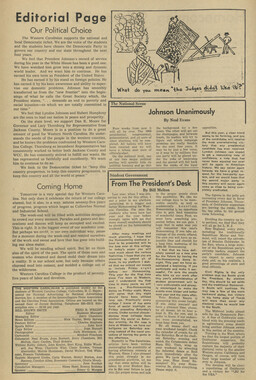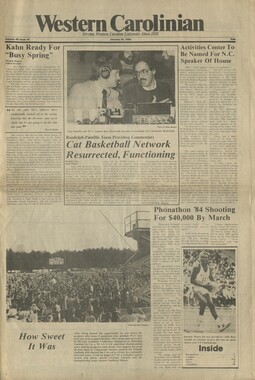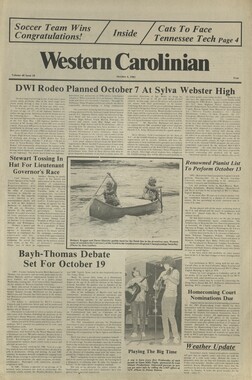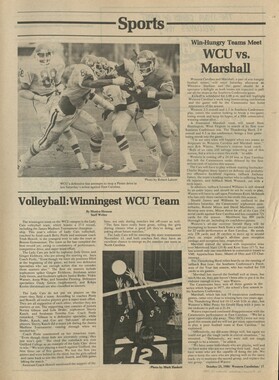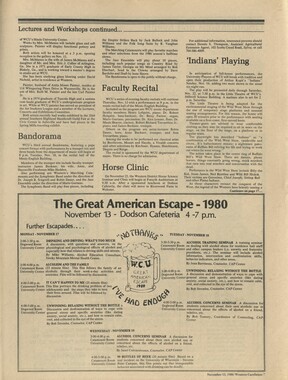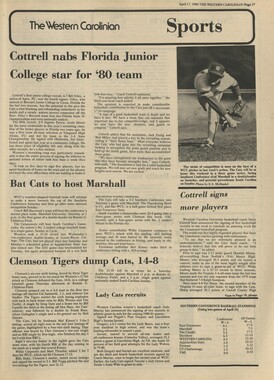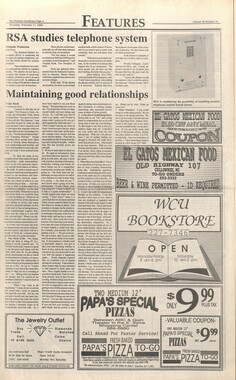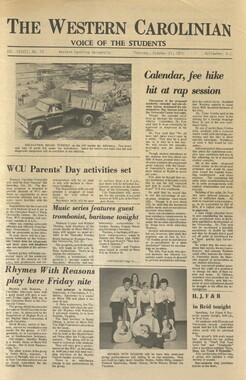Western Carolina University (20)
View all
- Canton Champion Fibre Company (2308)
- Cherokee Traditions (292)
- Civil War in Southern Appalachia (165)
- Craft Revival (1942)
- Great Smoky Mountains - A Park for America (2766)
- Highlights from Western Carolina University (430)
- Horace Kephart (941)
- Journeys Through Jackson (154)
- LGBTQIA+ Archive of Jackson County (85)
- Oral Histories of Western North Carolina (314)
- Picturing Appalachia (6772)
- Stories of Mountain Folk (413)
- Travel Western North Carolina (160)
- Western Carolina University Fine Art Museum Vitreograph Collection (129)
- Western Carolina University Herbarium (92)
- Western Carolina University: Making Memories (708)
- Western Carolina University Publications (2283)
- Western Carolina University Restricted Electronic Theses and Dissertations (146)
- Western North Carolina Regional Maps (71)
- World War II in Southern Appalachia (131)
University of North Carolina Asheville (6)
View all
- Allanstand Cottage Industries (62)
- Appalachian National Park Association (53)
- Bennett, Kelly, 1890-1974 (1388)
- Berry, Walter (76)
- Brasstown Carvers (40)
- Carver, George Washington, 1864?-1943 (26)
- Cathey, Joseph, 1803-1874 (1)
- Champion Fibre Company (233)
- Champion Paper and Fibre Company (297)
- Cherokee Indian Fair Association (16)
- Cherokee Language Program (22)
- Crowe, Amanda (40)
- Edmonston, Thomas Benton, 1842-1907 (7)
- Ensley, A. L. (Abraham Lincoln), 1865-1948 (275)
- Fromer, Irving Rhodes, 1913-1994 (70)
- George Butz (BFS 1907) (46)
- Goodrich, Frances Louisa (120)
- Grant, George Alexander, 1891-1964 (96)
- Heard, Marian Gladys (60)
- Kephart, Calvin, 1883-1969 (15)
- Kephart, Horace, 1862-1931 (313)
- Kephart, Laura, 1862-1954 (39)
- Laney, Gideon Thomas, 1889-1976 (439)
- Masa, George, 1881-1933 (61)
- McElhinney, William Julian, 1896-1953 (44)
- Niggli, Josephina, 1910-1983 (10)
- North Carolina Park Commission (105)
- Osborne, Kezia Stradley (9)
- Owens, Samuel Robert, 1918-1995 (11)
- Penland Weavers and Potters (36)
- Roberts, Vivienne (15)
- Roth, Albert, 1890-1974 (142)
- Schenck, Carl Alwin, 1868-1955 (1)
- Sherrill's Photography Studio (2565)
- Southern Highland Handicraft Guild (127)
- Southern Highlanders, Inc. (71)
- Stalcup, Jesse Bryson (46)
- Stearns, I. K. (213)
- Thompson, James Edward, 1880-1976 (226)
- United States. Indian Arts and Crafts Board (130)
- USFS (683)
- Vance, Zebulon Baird, 1830-1894 (1)
- Weaver, Zebulon, 1872-1948 (58)
- Western Carolina College (230)
- Western Carolina Teachers College (282)
- Western Carolina University (1794)
- Western Carolina University. Mountain Heritage Center (18)
- Whitman, Walt, 1819-1892 (10)
- Wilburn, Hiram Coleman, 1880-1967 (73)
- Williams, Isadora (3)
- Cain, Doreyl Ammons (0)
- Crittenden, Lorraine (0)
- Rhodes, Judy (0)
- Smith, Edward Clark (0)
- Appalachian Region, Southern (2569)
- Asheville (N.C.) (1923)
- Avery County (N.C.) (26)
- Blount County (Tenn.) (161)
- Buncombe County (N.C.) (1672)
- Cherokee County (N.C.) (283)
- Clay County (N.C.) (555)
- Graham County (N.C.) (233)
- Great Smoky Mountains National Park (N.C. and Tenn.) (519)
- Haywood County (N.C.) (3524)
- Henderson County (N.C.) (70)
- Jackson County (N.C.) (4694)
- Knox County (Tenn.) (25)
- Knoxville (Tenn.) (12)
- Lake Santeetlah (N.C.) (10)
- Macon County (N.C.) (420)
- Madison County (N.C.) (212)
- McDowell County (N.C.) (39)
- Mitchell County (N.C.) (132)
- Polk County (N.C.) (35)
- Qualla Boundary (981)
- Rutherford County (N.C.) (76)
- Swain County (N.C.) (2115)
- Transylvania County (N.C.) (270)
- Watauga County (N.C.) (12)
- Waynesville (N.C.) (84)
- Yancey County (N.C.) (72)
- Aerial Photographs (3)
- Aerial Views (60)
- Albums (books) (4)
- Articles (1)
- Artifacts (object Genre) (228)
- Bibliographies (1)
- Biography (general Genre) (2)
- Cards (information Artifacts) (38)
- Clippings (information Artifacts) (191)
- Crafts (art Genres) (622)
- Depictions (visual Works) (21)
- Design Drawings (1)
- Drawings (visual Works) (184)
- Envelopes (73)
- Facsimiles (reproductions) (1)
- Fiction (general Genre) (4)
- Financial Records (12)
- Fliers (printed Matter) (67)
- Glass Plate Negatives (381)
- Guidebooks (2)
- Internegatives (10)
- Interviews (815)
- Land Surveys (102)
- Letters (correspondence) (1013)
- Manuscripts (documents) (618)
- Maps (documents) (177)
- Memorandums (25)
- Minutes (administrative Records) (59)
- Negatives (photographs) (5835)
- Newsletters (1285)
- Newspapers (2)
- Occupation Currency (1)
- Paintings (visual Works) (1)
- Pen And Ink Drawings (1)
- Periodicals (193)
- Personal Narratives (10)
- Photographs (12976)
- Plans (maps) (1)
- Poetry (6)
- Portraits (4533)
- Postcards (329)
- Programs (documents) (151)
- Publications (documents) (2236)
- Questionnaires (65)
- Scrapbooks (282)
- Sheet Music (2)
- Slides (photographs) (402)
- Songs (musical Compositions) (2)
- Sound Recordings (796)
- Specimens (92)
- Speeches (documents) (15)
- Tintypes (photographs) (8)
- Transcripts (322)
- Video Recordings (physical Artifacts) (23)
- Vitreographs (129)
- Text Messages (0)
- A.L. Ensley Collection (275)
- Appalachian Industrial School Records (7)
- Appalachian National Park Association Records (336)
- Axley-Meroney Collection (2)
- Bayard Wootten Photograph Collection (20)
- Bethel Rural Community Organization Collection (7)
- Blumer Collection (5)
- C.W. Slagle Collection (20)
- Canton Area Historical Museum (2110)
- Carlos C. Campbell Collection (282)
- Cataloochee History Project (64)
- Cherokee Studies Collection (4)
- Daisy Dame Photograph Album (5)
- Daniel Boone VI Collection (1)
- Doris Ulmann Photograph Collection (112)
- Elizabeth H. Lasley Collection (1)
- Elizabeth Woolworth Szold Fleharty Collection (4)
- Frank Fry Collection (95)
- George Masa Collection (173)
- Gideon Laney Collection (452)
- Hazel Scarborough Collection (2)
- Hiram C. Wilburn Papers (28)
- Historic Photographs Collection (236)
- Horace Kephart Collection (861)
- Humbard Collection (33)
- Hunter and Weaver Families Collection (1)
- I. D. Blumenthal Collection (4)
- Isadora Williams Collection (4)
- Jesse Bryson Stalcup Collection (47)
- Jim Thompson Collection (224)
- John B. Battle Collection (7)
- John C. Campbell Folk School Records (80)
- John Parris Collection (6)
- Judaculla Rock project (2)
- Kelly Bennett Collection (1407)
- Love Family Papers (11)
- Major Wiley Parris Civil War Letters (3)
- Map Collection (12)
- McFee-Misemer Civil War Letters (34)
- Mountain Heritage Center Collection (4)
- Norburn - Robertson - Thomson Families Collection (44)
- Pauline Hood Collection (7)
- Pre-Guild Collection (2)
- Qualla Arts and Crafts Mutual Collection (12)
- R.A. Romanes Collection (681)
- Rosser H. Taylor Collection (1)
- Samuel Robert Owens Collection (94)
- Sara Madison Collection (144)
- Sherrill Studio Photo Collection (2558)
- Smoky Mountains Hiking Club Collection (616)
- Stories of Mountain Folk - Radio Programs (374)
- The Reporter, Western Carolina University (510)
- Venoy and Elizabeth Reed Collection (16)
- WCU Gender and Sexuality Oral History Project (32)
- WCU Mountain Heritage Center Oral Histories (25)
- WCU Oral History Collection - Mountain People, Mountain Lives (71)
- WCU Students Newspapers Collection (1744)
- Western North Carolina Tomorrow Black Oral History Project (69)
- William Williams Stringfield Collection (2)
- Zebulon Weaver Collection (109)
- African Americans (390)
- Appalachian Trail (35)
- Artisans (521)
- Cherokee art (84)
- Cherokee artists -- North Carolina (10)
- Cherokee language (21)
- Cherokee pottery (101)
- Cherokee women (208)
- Church buildings (170)
- Civilian Conservation Corps (U.S.) (110)
- College student newspapers and periodicals (1830)
- Dams (107)
- Dance (1023)
- Education (222)
- Floods (61)
- Folk music (1015)
- Forced removal, 1813-1903 (2)
- Forest conservation (220)
- Forests and forestry (1184)
- Gender nonconformity (4)
- Great Smoky Mountains National Park (N.C. and Tenn.) (181)
- Hunting (38)
- Landscape photography (25)
- Logging (118)
- Maps (83)
- Mines and mineral resources (8)
- North Carolina -- Maps (18)
- Paper industry (38)
- Postcards (255)
- Pottery (135)
- Railroad trains (71)
- Rural electrification -- North Carolina, Western (3)
- School integration -- Southern States (2)
- Segregation -- North Carolina, Western (5)
- Slavery (5)
- Sports (452)
- Storytelling (244)
- Waterfalls -- Great Smoky Mountains (N.C. and Tenn.) (66)
- Weaving -- Appalachian Region, Southern (280)
- Wood-carving -- Appalachian Region, Southern (328)
- World War, 1939-1945 (173)
Western Carolinian Volume 52 Number 07 (08)
Item
Item’s are ‘child’ level descriptions to ‘parent’ objects, (e.g. one page of a whole book).
-
-
The Western Carolinian 8 ^^a7 September 18, 1986 Counselor's Corner "Fighting the Fair Way" Rick Barrett Generally we think of fights as angry confrontations between two or more people where tempers flare, voices are raised, and insults are exchanged. This way of resolving conflict, while unfortunately common, usually results in bitterness, aistrust, and desire for revenge. The issues may be temporarily settled, but one or both partners feel resentful, angry or hurt. Both partners can experience a loss of intimacy. Disagreement and conflict are inevitable in intimate relationships. For a relationship to proceed toward intimacy, individuals must be willing to express and explore differences in attitudes, values and emotions. Powerful emotions, including anger, are an aspect of deeply shared experiences and reflect concern and caring. However, the manner of expressing anger may completely overshadow any underlying caring messages. Styles of expressing anger are learned and therefore can be changed. Angry feelings depend on one's perception of the situation. So, aeveloping self-knowledge, and listening and communication skills are the keys to fair fighting. Clean, fair fights are confrontations in which disagreements and grievances are dealt with according to a specific set of guidelines. Applying these principles, along with the skills of active listening (e.g., listening and responaing to other's communications in a manner that conveys understanding, interest and respect) and a collaborative attitude allows differences to be negotiated. Both partners will be likely to feel refreshed, resolved and relieved that important issues have been dealt with. Successful fights tend to clear up problems and increase intimacy by helping each partner understand the other better. The following guidelines highlight some of the major fair and unfair fighting techniques couples use with each other. Remember, what you need to decide is not Should I express my anger?" or even "How should I express my anger?", but "How can I communicate to my partner about this issue so that he or she will do something about it?". Some general suggestions for fair fighting include: Deal with small but significant issues when they happen; be willing to let go of anger generated by trivial issues; pick a good time and deal with big issues as soon as possible - preferably when you're both prepared to deal with them - make and keep an appointment to fight if necessary; know what you're fighting about - be specific, limited and direct with your complaint. There tend to be several phases to a fight. These may be generally categorized as Initiating, Responding, Negotiating, and Ending. INITIATING 1. Report your anger appropriately using "I" statements ("I'm furious about..."). 2. Be specific and concise. 3. Say what you really mean. 4. Stay in the present; use current examples. 5. Deal with your partner's behavior, not their personality. Unfair Approaches - Generalizing - "You never..." or "I'm always..." Labeling, name calling, character assassination - Misleading - telling your partner what he or she is thinking and feeling. - Dwelling on past grievances - Accusations, blaming your partner for your problem Hitting below the belt, purposely calling attention to known weaknesses or areas of sensitivity - Exaggerating - overreacting to a situation or making idle threats or ultimatums RESPONDING 1. Count to 10, or more if you're really attacked. 2. Be an active listener - express back to your partner what you understand his/her thoughts and feelings are. 3. Be sensitive. Avoid fighting back when your partner is just letting off steam. 4. Let your first response to a grievance be an attempt to understand your partner's perceptions, values and feelings. 5. If you're wrong, admit it. Unfair Responses - Cross complaining, responding to partner's initial complaint with one of your own - Ignoring your partner - Belittling your partner or the issues - Assuming your partner should know what you are thinking or feeling when you haven't said anything • Sulking NEGOTIATION Body Talk from Graham Infirmary 1. After you understand how your partner is feeling, try to find out what it is your partner hopes to obtain by making the complaint. 2. Express your interest in coming to a solution which is satisfactory to you both...a position in which you both can "win". AH CHOO! 3 Discuss each other's perception^ How is it that your partner sees things so differently from you? 4 Keep to the subject. Try to resolve one issue before moving to another. Unfair Negotiating -""presenting non-negotiable demands - Thinking your partner must lose if you are to win - Ignoring your partner's strong expression of emotions ENDING 7" Have physical safety valves for excess emotion (e.g., jogging, biking, listening to mus.c). 2. Be ready to forgive. 3 if the fight isn't resolved right now, make an appointment to finish it later. Allow for interim solutions. ... 4 If the fight is resolved, try to finish with an expression of positive feelings that you have workea together successfully. Unfair Conclusions Pretending to go along or agree when you really don't Withholding affection, breaking previous agreements - Continuing with repetitious, stale arguments with no progress being made toward resolution All of the previous fair fighting suggestions assume that both partners want the relationship to survive the conflict. For many of us, it is difficult to accept that someone can be angry with us and still like and care about us. However, the survival of intimate relationships depends upon our willingness to confront conflict and fight fairly. ACKNOWLEDGEMENT: Some of the suggestions for "Fair Fighting" are taken from the book THE INTIMATE ENEMY by Dr. George Bach and Peter Wyden. Hay Fever's Here Again. It's that time again! Those of you who suffer from seasonal allergies, also known as "hay fever", are well aware the time is here. Symptoms of hay fever include sneezing, runny stuffy noses, and itching eyes, and they're most often incited by pollen from trees, grasses or weeds. Sufferers usually get blessed relief when cold weather arrives. You're not alone. The misery caused by "hay fever" is extensive, if the large number of products used to treat the condition is an indication. At least 28 pharmaceutical companies in this country market over 40 different drugs intended primarily for hay fever. Antihistamines decongestants, alone or in combination, are the most commonly used, though nasal corticosteroids are sometimes prescribed. The symptoms are produced maihly by histamine, a small molecule that is normally stored within so-called mast cells, which are located in a variety of tissues. Histamine that remains inside the mast cells is innocuous. When released, however, it triggers allergic responses. In the lining membrane of the nose, this translates into itching, sneezing, clogging, and dripping. Why does the allergic person release excessive histamine? First, the individual reacts to pollen or other particles (known collectively as allergens) by producing antibodies to them. These "allergic" antibodies are secreted into the mucus of the nose. When allergens are inhaled and trapped by the mucus, the antibodies bind to them. Once bound, the allergen-antibody complexes become attached to the surface of mast cells. This is the event that signals the mast cells to release their histamine molecules. After release, the molecules diffuse away from the mast cells until they encounter target cells with receptors that are sensitive to histamine. The receptors, activated by the histamine, switch on the allergic response. Antihistamines are probably the most commonly used drugs to relieve allergy symptoms. They simply block the access of histamine to target- cell receptors. Nasal decongestants such as Focus on The Organization of Ebony Students Sudafed and Afrin mainly inhibit only one of the body's responses to histamine: The dilation of blood vessels. They thus reduce swelling of nasal tissue and the resulting sense of stuffiness. But they only work well for two or three days, after which they are likely to produce "rebound" stuffiness and irritation of the nasal passages. Antihistamines can produce drowsiness, dizziness, blurred vision, insomnia, tremors, nauses, and dry mouth. However, these side effects can be minimized and mild cases of seasonal hay fever can often be effectively controlled if antihistamines are taken properly. The bestapproach is to startwith relatively small doses of pure antihistamine, not in combination with a decongestant and not in a timed-release form. Chlor-Trimeton and Dimetane are two common brands of over-the-counter antihistamines, and less expensive generic equivalents are available. The drug should betaken around the clock, in an amount not exceeding the Kim Rene Morris - OES President by Andrew Dawkins Editor-in-Chief "I became curious as to why there was such a striking lack of unity among the blacks on this campus, especially when we are so few in number. I wanted to become involved in the OES in order to try to close the gap that exists between us blacks. I wanted to make my own contribution to this process." Those were the reasons Kim Morris, Vice—President (1986-87) for the Organization of Ebony Students gave for becoming involved with the campus organization which attempts to provide a social and cultural support system for black students. Kim was born in Newburgh, New York on August 10, 1966, the last child in her family. She has three sisters, and two brothers. At age nine Kim and her family moved to Charlotte, North Carolina where they now reide. She attended Cochrane Junior High, and Myers Park Senior High before coming to Western Carolina University. Kim is a social work major with a minor in psychology. Her immediate career plans include going on to graduate school to persue a master's degree in Psychiatric or Administrative Social Work. Her responsibilities as OES Vice-President include chairing the meetings of the organization's executive board, sharing the administrative chores with the other executive board members, planning and implementing social activities, being there to offer a listening ear to those who might need it, and helping a member student with a question or problem. Coming as she does from a "very tight" family, Kim understands the need for, and benefits that can result from unity. Her goals for OES include increasing the membership of the organization, getting blacks involved in the activities planned by OES, and changing the image of the organization and making it more attractive and more responsive to the needs of those it was created to serve. Kim expressed displeasure, and some impatience with students who prefer to sit and belittle the organization for its past failings. She would prefer, she stated, to have these students instead focus their attention and energy into helping the new administration turn the organization into the vital force it has the potential to become. She stated that she is willing to listen to any and all ideas and suggestions. She will make herself available, she said, to anyone who is interested in the organization and who wants to talk to her. She issued a challenge to those who are still focusing on the past, and still critical of the effectiveness of the organization to attend future meetings with the aim in mind to start afresh the effort to build the organization . The next scheduled meeting, she pointed out, will be September 25,1986 at 7 p.m. in the OES offices in the Old Student Union Building. Meetings are held every other Thursday. There will also be a free party on September 20. Black Parents' Weekend, an annual event sponsored by the organization, will be on November 14-16, 1986. Sigma Ihefa Tau nursing honor society will meet Tuesday, Sept.23, at 7 p.m. in the Haywood Savings and Loan Building, 505N. Main St., Waynesville. Speaker will be Janet Ladd of Waynesville, director of medical/surgical nursing at St. Joseph's Hospital in Asheville, who will speak on "Roots of Excellence." A short business meeting and selection of new members will follow the talk. For more information, contact Martha B. White dose recommended by the instructions. After the first forty-eight hours the unpleasant side effects are likely to wear off, but the drug remains effective against hay fever symptoms. A weekend at the beginning of pollen season may be the best time to try this approach. When antihistamines are taken around the clock, a rather small total dose is often all that is needed to control symptoms and keep side effects to a minimum. Here at Graham Infirmary we have a limited number of medications to help with your allergy symptoms. Or is you're on of those sufferers who do not get enough relief with over-the-counter medicine, feel free to come talk with our physicians or physician assistant for other possible remedies. Their hours are Monday-Friday, 9am to 5pm, with an hour off from 12 to 1pm for lunch. Our phone number is 7430 or 7431. Delta Sigma Phi Fraternity will be having a road block for the March of Dimes on Friday, Sept. 19, 1986. We would appreciate everyone's support in our effort. NEED TO TALK ABOUT BEING GAY? TIRED OF HOMOPHOBIA? WANT TO SHARE IDEAS ABOUT GAY LIFESTYLE IN A SAFE, POSITIVE SETTING? TIRED OF TRYING TO HANDLE IT ALONE? HAVING PROBLEMS IN YOUR RELATIONSHIP? NEED SOME ANSWERS? Lesbian & Gay Rap Group Meetings Every Wednesday From 6pm to 73°pm. For More Info, Write To: P.O. Box 2646 Cullowhee, NC 28723 MOUNTAIN HERITAGE CEJO^R CURRENT ATTRACTIONS Tradition and Revival in Mountain Handweaving Includes a full-size log cabin and WEAVING WEDNESDAYS each Wednesday weavers will work on a coverlet in the Gallery. Mountain music and historic photographs tell the sfo?y~oHhV' Revival of Handicrafts in Southern Appalachia Alpha Kappa Alpha Sorority, INC. The sorors of Alpha Kappa Alpha Sorority will be holding their Second Annual "Helpful Hints Reception* on Tuesday September 23,1986 at 8:00pm in the Cherokee Room. This event is held to acquaint the Black Freshman with the Black Faculty and Staff at Western Carolina. The sorors of AKA will be having a party on September r9th in the Cherokee Room. It will be .50C before 10:30 pm and $1.00 after. MiSBlion Scotch-Irish People Permanent exhibit looks at this important group of early Appalachian settlers Includes a full-size Irish stone house with thatched roof. 4 • _+ also a Carolina blue wagon, FDR in Sylva, Horace Kephart's fishing lures, Ty Cobb's autograph, Dr. Daisy's Footpowered Drill, Cullowhee from 600 miles up, !*-?£=. and many other surprises <=z£n open weekdays, 8 to 5 (704) 227-7129 Western Carolina University on the first floor, H. F. Robinson Administration Building Cullowhee, N. C II IIIIIIIIIIIIIIIIIIIIIIHIIIIIMI I
Object
Object’s are ‘parent’ level descriptions to ‘children’ items, (e.g. a book with pages).
-
The Western Carolinian is Western Carolina University's student-run newspaper. The paper was published as the Cullowhee Yodel from 1924 to 1931 before changing its name to The Western Carolinian in 1933.
-
